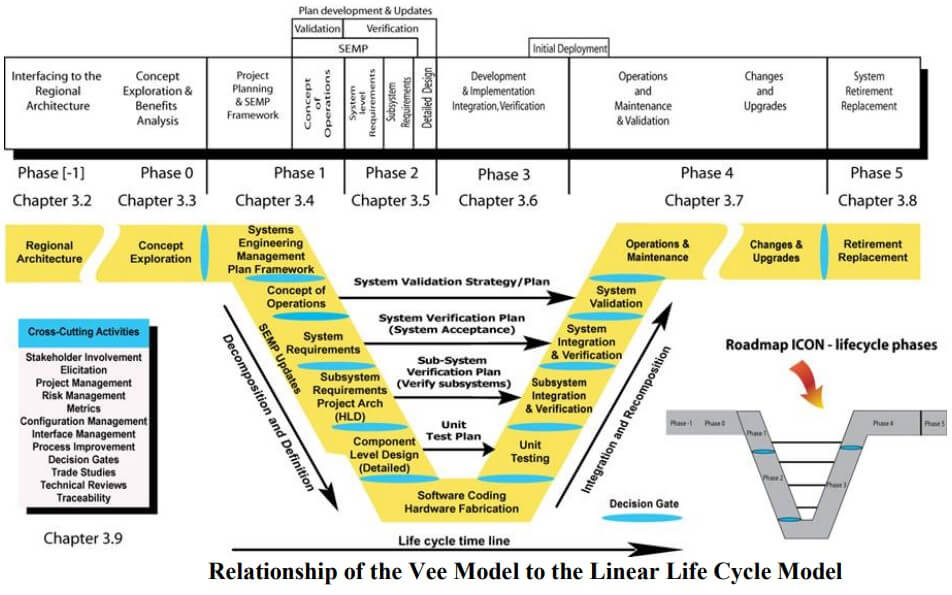The Systems Engineering V-model employs a V-shaped framework to illustrate the system’s lifecycle stages. The left side represents initial phases like requirements gathering, analysis, and design. In contrast, the right side signifies later stages such as testing, integration, and deployment. Throughout, the V-model emphasizes traceability and verification, ensuring that requirements are met, risks are mitigated, and a highly reliable final system is achieved.
Table of Contents
Overview of the Systems Engineering V-model
The Systems Engineering V-model is distinguished by its V-shaped diagram, illustrating various stages in the system’s development lifecycle. It starts at the top left with requirements gathering and analysis, followed by design. It then proceeds down the left arm, entering implementation and integration. Finally, it ascends the right arm, undergoing thorough testing, verification, and validation before reaching deployment and maintenance.
Benefits of the Systems Engineering V-model
The Systems Engineering V-model offers several key benefits, including:
- Structured Approach: The V-model provides a systematic and structured approach to system development, ensuring all necessary steps are considered and executed in a logical manner.
- Traceability: Each development stage of the V-model is interconnected, promoting traceability. By maintaining traceability, system engineers can easily track requirements, design decisions, and any changes made throughout the development lifecycle.
- Risk Mitigation: The V-model emphasizes early identification and mitigation of risks. By conducting thorough testing and verification at each stage, potential issues can be identified and addressed before they escalate, reducing the overall project risk.
- Quality Assurance: With its focus on validation and verification, the V-model ensures that the final system meets the specified requirements, is of high quality, and functions reliably.
Application of the Systems Engineering V-model
The Systems Engineering V-model finds wide application across various industries for the development of complex systems. Some of the domains where the V-model has proven particularly effective include:
- Aerospace and Aviation: The V-model aids in aerospace and aviation, ensuring safe systems for aircraft, rockets, and spacecraft.
- Automotive: It develops advanced vehicle systems, including safety features, infotainment, and autonomous driving.
- Software Development: It’s valuable in software engineering for systematic development, testing, and deployment.
- Defense: For defense, it aids in developing military systems, from surveillance to communication.
- Healthcare: It’s used to create medical devices, patient monitoring, and healthcare technologies.
History of the Systems Engineering V-model
The Systems Engineering V-model has its roots in the development of systems engineering methodologies starting in the mid-20th century. Let us take a closer look at the evolution and history of this influential framework.

Early Development of Systems Engineering
In the 1940s and 1950s, as technology became more complex, engineers started to recognize the need for a structured approach to develop and manage intricate systems. This led to the development of systems engineering, an interdisciplinary field that focused on the holistic approach to system design, development, and operation.
During this period, traditional engineering disciplines were expanding, and industries such as aerospace, defense, and manufacturing faced increasing system complexity. Engineers realized the importance of having a comprehensive methodology to address the challenges posed by these complex systems.
Introduction of the V-model
In the 1970s and 1980s, the concept of the V-model emerged as a graphical representation of the systems development lifecycle. It gained popularity due to its ability to outline the sequential steps involved in developing complex systems, from requirements gathering to deployment.
The V-model’s name is derived from the shape of its diagram, which resembles an inverted ‘V’. This shape signifies the downward movement during system development, from requirements definition to integration and implementation, and the subsequent upward movement through testing, verification, and validation.
Adoption across Industries
As the Systems Engineering V-model gained recognition for its effectiveness, it began to find applications in various industries. It particularly gained prevalence in safety-critical sectors such as aerospace, defense, and automotive industries, where the accurate and reliable functioning of systems holds utmost importance.
The V-model’s ability to provide traceability, mitigate risks, and assure quality made it the preferred choice in these domains. Furthermore, its structured and systematic approach ensured that organizations consistently developed complex systems, meeting rigorous standards and regulatory requirements.
Over time, experts have refined and adapted the Systems Engineering V-model to specific industry contexts and project requirements. They have developed different variants of the V-model to tailor the framework to specific methodologies or regulatory standards, thus further enhancing its utility.
Continued Relevance in Modern Systems Engineering
Even in the present day, the Systems Engineering V-model remains a valuable tool in the field of system engineering. As technology continues to evolve and systems become more intricate, the V-model’s structured approach continues to provide engineers with a solid foundation for developing reliable, high-quality systems.
The V-model has also influenced the development of other lifecycle models, such as the iterative and incremental models, which further enhance the flexibility and adaptability of system development processes.
Wrap Up
In conclusion, the Systems Engineering V-model stands as a valuable framework for complex system development and management. Its structured approach, emphasis on traceability, and risk mitigation contribute to high-quality outcomes. Originating in mid-20th-century systems engineering, the V-model has evolved and gained widespread adoption across industries. It retains relevance in the modern-day, offering engineers a steadfast foundation for building reliable systems. Adhering to the V-model, system engineers can confidently navigate the intricacies of development, ultimately delivering successful and resilient solutions.
Check out our review of the Top 10 Online Systems Engineering Courses







